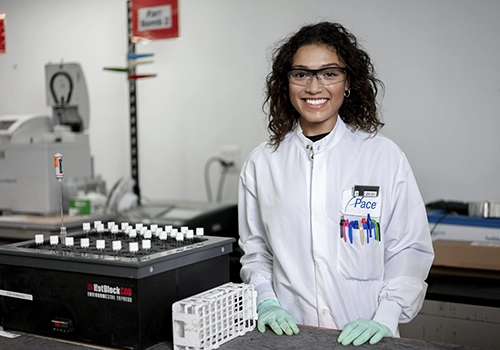Pace® WET Testing Services
Pace® offers comprehensive Whole Effluent Toxicity (WET) testing services to help our customers evaluate the potential impact of industrial and municipal effluents on aquatic ecosystems. With a team of experienced professionals and a network of state-of-the-art testing laboratories, Pace® provides defensible results for regulatory compliance and in support of sustainable business practices across a wide range of industries. The primary types of WET Testing services offered include:
- Content of VOCs
- Chronic WET Testing
- Toxicity Identification Evaluation (TIE)
- Chemical and Pure Product Testing

What Is Whole Effluent Toxicity (WET) Testing?
Whole Effluent Toxicity or WET Testing is a critical component of environmental management and industrial risk mitigation as it analyzes the aquatic toxicity of wastewater effluent. WET Testing is often required for National Pollutant Discharge Elimination System (NPDES) permitting. A WET test can be used to determine whether effluent may have an adverse impact on aquatic life (vegetation, vertebrates, and invertebrates) or to evaluate the effectiveness of biological treatment processes.
Types Of Whole Effluent Toxicity Testing
Acute WET Testing measures mortality by exposing living aquatic organisms to various concentrations of wastewater sample, usually from a facility’s effluent stream. Test duration for Acute WET Testing usually ranges from 24 to 96 hours. Acute WET Testing may also be referred to by terms such as "24-hour LC50" or “96-hour LC50.” LC50 refers to the test concentration that is lethal to 50 percent of the test organisms after the specified period.
Chronic WET Testing measures the long-term effects of exposure to pollutants by observing the response of test species over a longer period, usually spanning several generations or life cycles. Chronic WET Testing also includes sublethal endpoints, which can detect the effects of pollutants on growth or reproduction of test species.
Toxicity Identification Evaluations are undertaken to characterize and identify toxic constituents in an effluent when bioassay data reveal persistent toxicity. The TIE Phase I Toxicity characterization tests characterize the physical/chemical properties of the effluent toxicants using effluent manipulations and accompanying toxicity tests.
Chemical and Pure Product Testing assesses the potential adverse effects caused by chemicals or pure products on aquatic organisms. These tests involve exposing selected groups of organisms to varying concentrations of an aqueous solution of the chemical or pure product to determine if lethal or sub-lethal effects are observed. Chemical and Pure Product Testing can also be used to establish a concentration-response relationship, which relates the endpoint measured in the test (e.g., mortality, growth, reproduction) to the concentration of the chemical or pure product.

Pace® Supports Your Environmental Project Needs
Pace® WET Testing services can be used to identify the type and concentration of contaminants in water to verify the effectiveness of toxicity reduction efforts.
NPDES permits are used to monitor and manage the discharge of toxic pollutants in wastewater, and NPDES permitting may include WET Testing requirements.
Stormwater runoff is another type of wastewater discharge that may be covered by NPDES permitting requirements.
The reject stream from the reverse osmosis water purification process often contains concentrated contaminants. WET Testing can help safeguard aquatic ecosystems and human health.
LC50 is the lethal concentration of a pollutant that kills 50% of test organisms. IC25 causes a 25% reduction in biological function. NOEC is the highest concentration causing no observable adverse effects.
An Ion Imbalance Evaluation is used to determine the imbalance in the concentration of different ions in a body of water. Ion imbalance can be caused by a range of factors, such as wastewater discharges, agricultural runoff, and mining activities.
Pace® Simplifies The Entire Lifecycle Of Your Project
Pace® offers a variety of services to support our customers’ aquatic toxicology programs as well as compliance with NPDES permitting and other regulatory programs. In addition to whole effluent toxicity testing services, we can also help with:
- Test Scheduling
- Sample Collection Kits
- Sampling Services
- State-Specific Quarterly Testing Reports
- Quality Assurance Documentation
- Reference Toxicant Control Charts
- Toxicity Issues Consulting
Additional Resources
Need to find a lab that can handle your unique requirements?
Contact us directly or download our list of environmental certifications across our network.